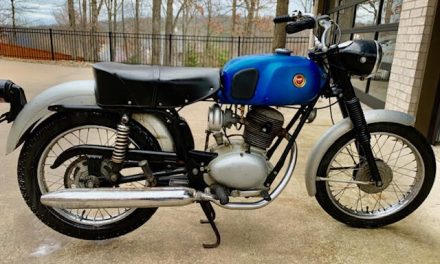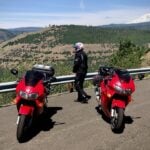With Harley-Davidson’s recent withdrawal from factory racing, our friends at ThrotteStop showcase two bikes that challenged the competition in the 1980s-2000s.
By 1987, the Harley-Davidson Motor Company had regained its financial footing after independence from corporate owner AMF. Part of the company’s plan for reinvigorating the brand lay in a time-honored strategy – factory-sponsored racing. But years of tepid technical advancement in their product line had left the Motor Company woefully uncompetitive on the racetrack. A radical leap in engine and chassis development was needed – advancements which would help Harley-Davidson navigate the subsequent decades.
Given Harley’s market position in large-displacement street bikes, the AMA’s 1000cc V-Twin Superbike roadracing class was the logical venue. The Harley-Davidson VR1000 introduced a revolutionary water-cooled, double-overhead cam, fuel-injected V-Twin engine within an all new chassis, designed to put class leader Ducati on notice.
For the project, Harley looked internally to some of their own talent. Erik Buell, a former HD employee turned contractor, was well known in roadracing circles for his innovative problem solving. Harley designer Mark Miller was tasked with developing the new powerplant within parameters outlined by Buell. Consulting on the project was famed Formula 1 constructor Cosworth of England. Initially, Buell’s concept used one-half of Cosworth’s proven BDG 2000cc V-4 engine narrowed to a 60-degree configuration. This bore and stroke architecture was later rejected when Steve Scheibe, formerly of Roush Industries, joined the design team in 1989.
Cosworth found that the VR1000’s four-valve heads could best be optimized by a large, free-flowing airbox. That space only existed where a conventional gas tank would fit, so Buell patented a fuel-in-frame chassis which would become the first such configuration used in a modern motorcycle. Engine vibration inherent from the narrow V-Twin was similarly addressed with a uniplanar rubber mounting system. Ultimately, the design would reject Buell’s innovative frame for a more traditional structure, but it would later appear in the Buell XB sportbike of 2003.
Finally introduced at the 1994 Daytona 200, the long gestation period of the VR1000 meant it was already a step behind, and plagued with teething problems. Compounding its development was that the Motor Company was enjoying a pop cultural moment, and working overtime to fill unprecedented order volume for its suddenly-fashionable street bikes. To give the VR1000 the attention it needed, all racing activities were outsourced to an independent entity named Gemini Racing, until the program abruptly ended after the 2001 season.
Though never posting a winning season, the VR1000 could be considered a technical success, if not an expensive engineering exercise. 55 total motorcycles were believed produced, with an additional 8 spares, at a rumored cost of $50 million dollars spent over the span of the 14-year program.
The engine would live on in Harley’s street-legal production muscle bike, the 2001 V-Rod. With help from German automaker Porsche, the VR1000’s 60° V-twin was developed into a smooth street motor. Enjoying a strong 16-year run, the V-Rod became the best-selling Harley overseas, opening up important new markets to the Milwaukee manufacturer and ushering in an era of water-cooled motorcycles for the company.
The engine entered drag racing competition in the form of the 2006 V-Rod Destroyer. Only 625 units were made available to the public, and the track-only bike featured an increased bore and stroke, larger valves and throttle bodies, and high-lift cams and forged pistons.
The Throttlestop Museum is proud to showcase the amazing motorcycles of this significant period in Harley-Davidson’s evolution. Our 1994 VR1000 was formerly owned by Mike Canepa’s 10-K Racing team campaigned out of San Jose Harley-Davidson by rider Chris Carr. Included with the bike were numerous spares, now arranged in a unique wall display that drive home the point that the VR1000 was truly the sum of its innovative parts.
ThrottleStop’s 2006 Harley-Davidson Destroyer boasts a 1,300cc engine producing approximately 165hp, capable of ET’s of low-9 seconds at over 140 mph. Riding it requires a NHRA Pro license to handle its near 2G launch.
Rumors persist about a new VR1000-based Harley sportbike being developed. If so, the frustrating competition history of Harley-Davidson’s AMA Superbike project will give way to a new chapter in Harley production motorcycles – proving once again that racing improves the breed.
Bill Hall
Throttlestop Museum
*photos by Throttlestop, V-Rod by Porsche
*For a virtual tour of their motorcycle museum, click here: Throttlestop Virtual Museum
*For Throttlestop’s monthly blog, click here: Throttlestop Blog






























I saw it run as a prototype at Elkhart Lake in early testing, probably in the late 80’s. I told my local Harley dealer I saw a water-cooled Harley Race Bike and he didn’t believe me! I guess this article probably proves what I saw. Interesting, I have a 1/9 scale diecast model of that sitting on my desk right now and it has for about 25 years or so. Good article.
Thanks Terry, appreciate the comments. A bucket list item would be to ride one, but I’m guessing it’ll remain just that- bucket list. Best to ya!
I saw Pascal Picotte get 2nd at the Sears Point National in the late 90s on a VR1000. The bike did have a few good performances.
Years ago I read homologation, street legal versions, were readily available in Poland of all places.
More trivia: https://raresportbikesforsale.com/tag/pascal-picotte/
Thanks for sharing the link, Jeff, We’ll give that a look, for sure.
There is no motorcycle on this planted that is better than a Harley davidson v rod muscle not ever the new motorcycle that Harley davidson wannabe Harley davidson v rod muscle motorcycle
Harley’s VR1000 and V-Rod Destroyer are true legends in the world of motorcycles. These iconic bikes have left an indelible mark on the industry, combining power, style, and innovation. They continue to inspire riders and enthusiasts alike, showcasing Harley-Davidson’s commitment to pushing boundaries in the pursuit of greatness.
These legendary Harley-Davidson bikes, the VR1000 and V-Rod Destroyer, represent a fascinating blend of tradition and innovation. The VR1000, with its foray into superbike racing, showcased Harley’s racing spirit. The V-Rod Destroyer, a drag racing beast, pushed the limits of performance. Both are iconic in Harley’s rich history.
Harley’s VR1000 and V-Rod Destroyer represent iconic milestones in motorcycle history. The VR1000 broke new ground with its innovative design, while the V-Rod Destroyer pushed the limits of power and performance. These legendary bikes continue to inspire and captivate motorcycle enthusiasts worldwide.